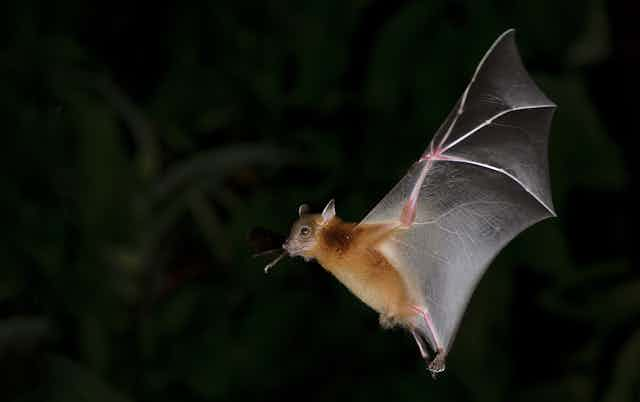Why do bats pass deadly diseases like ebola to humans? – Sreehari, aged nine, Kerala, India
This is a great question – and it’s one that doctors and scientists have been investigating for a while. The reasons bats pass lots of diseases to humans have to do with their unique lifestyle and how they have evolved.
Bats are both more likely than other animals to have a wide variety of diseases like Ebola, rabies and coronaviruses and more likely to pass them on to us.
Flight and defence against disease
Bats are the only freely flying mammals, and a lot of their biology is about flight. Flying requires lots of energy, so bats have to eat high-quality diets. A diet of leaves, which are low in energy, would not be enough for most bats. They generally prefer sugar and protein-rich foods like fruit, pollen, insects, spiders, small animals and even blood.

Curious Kids is a series by The Conversation that gives children the chance to have their questions about the world answered by experts. If you have a question you’d like an expert to answer, send it to curiouskids@theconversation.com and make sure you include the asker’s first name, age and town or city. We won’t be able to answer every question, but we’ll do our very best.
Most of a bat’s energy is needed to power its wings, so other systems in its body have evolved to be very efficient. The immune system is a particularly good example. Scientists have shown again and again that when a bat gets a disease that would be serious or fatal to humans, they barely seem to get ill.
Where your body might have to fight hard to beat a disease, making you ill in the process, a bat’s body just tolerates it. This means they stay healthy and able to fly and feed when infected.
In fact, a bat’s body is so good at tolerating diseases that they just tend to have more of them than we do. This means that even a healthy-looking bat can be a carrier for several diseases.
Bats are sociable and long-lived
Most bats live in large social groups and interact closely with one another. They take care of other group members – vampire bats, for instance, regurgitate food for friends that have not managed to find any. Bats also live longer, on average, than other mammals of a similar size. Size is linked to lifespan, with larger animals typically living longer and more slowly.

When we remember that bats also tolerate disease well, we can see that being very social means that members of a typical bat population are likely to pass a lot of diseases to each other – and are unlikely to die in the process.
This makes a typical bat group something of a hotbed for disease. It also means that diseases that can infect bats have a good chance of mutating into new forms. Since the bats’ immune systems protect them from illness, the diseases can sit tight inside nice warm bat bodies for months or years, and have plenty of time to evolve. This is why bats might be important sources of new diseases, as well as passing on older ones.
Flying brings bats closer to us
Bats are found around the world, and there are lots of them – over 1,200 different species. This means we are never too far from a bat – especially as they can fly long distances.
In some parts of the world you don’t have to worry as long as you don’t handle bats. Insect-eating bats, for instance, only transmit diseases to humans by direct contact or by contaminating food with their poo (which is very rare).
In other places, bats might be eating the same fruit as local humans. Humans can then pick up diseases from bat saliva. In some cases, bats themselves are eaten by humans. As bats can look healthy even when they are not, eating a bat is particularly risky.

